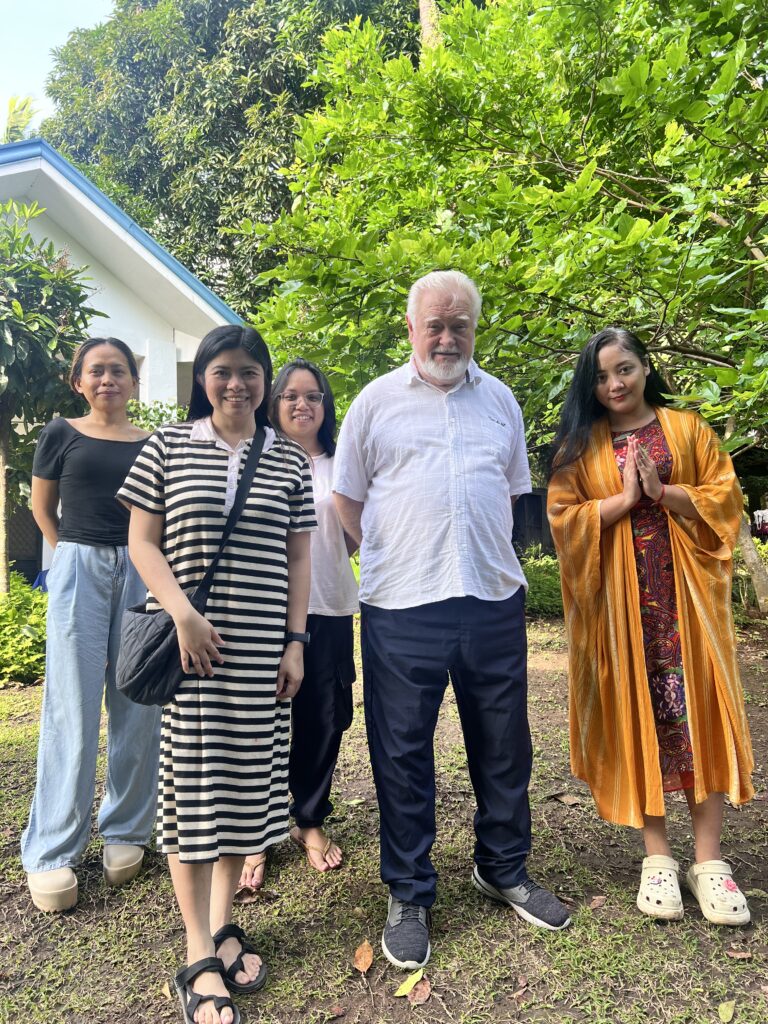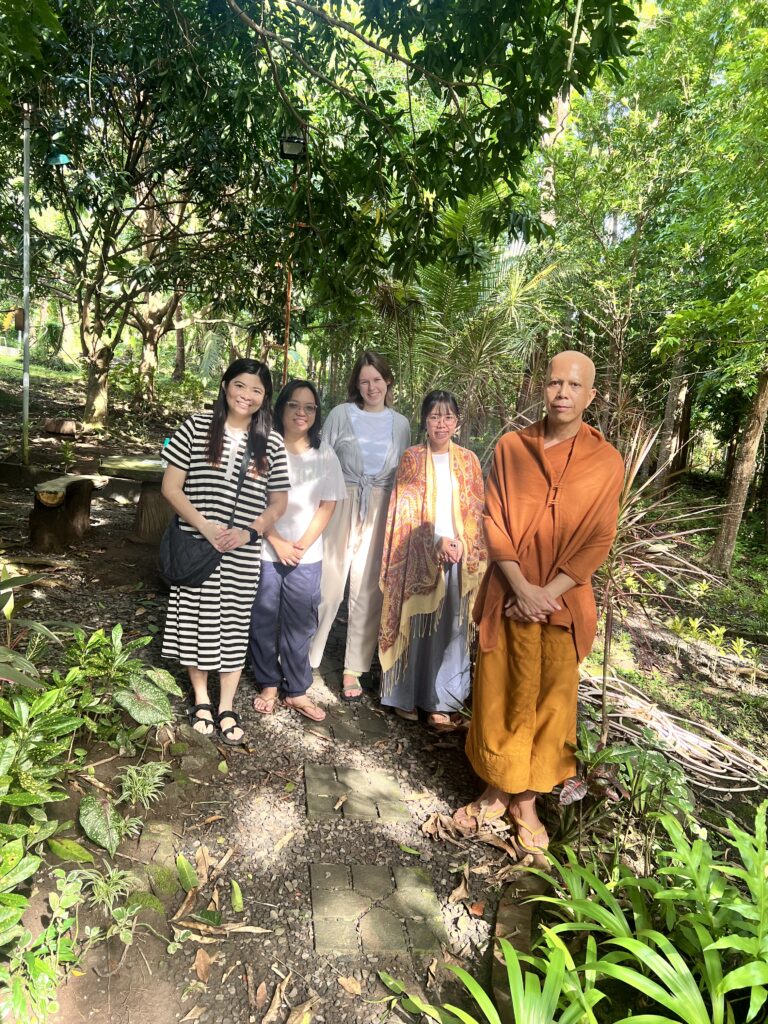
My Vipassana Journey
Having had an incredible experience during my first Vipassana last March 2023, I promised myself that when the time came and I had enough free time, I would register again to sit for another Vipassana meditation course.
And so, I recently did. But this time, the experience was much deeper than the first one. I tried harder to follow the guidelines imposed by the center—rules that exist for the benefit of the students.
So, what is Vipassana?
Vipassana is a mind-training meditation technique rediscovered by Gautama Buddha. It helps develop awareness and equanimity in response to craving or aversion—the reactive patterns created at the deepest layer of the mind. This reaction is known as sankhara. Craving or aversion is said to be the root cause of human misery.
Misery begins at birth. When a baby craves milk, a sankhara of craving may develop. When a baby becomes upset because the weather is too hot to sleep, a sankhara of aversion may arise. Each time we react with craving or aversion, a new sankhara is created. Repeated reactions compound these sankharas until they become mental defilements. In a single day, a person can generate thousands of sankharas through this process of multiplication. No wonder we become more miserable as we grow older—especially if our minds are not equanimous.
The entry point of human misery is through the five senses—smell, sight, touch, hearing, and taste. To reach the root of our suffering, we must observe physical sensations without reacting. To correct the issue, we must apply equanimity.
Let me give an example of how this works at each layer of the mind:
Scenario: Someone gives you a compliment.
| Layer of the Mind | Activity |
| Surface level | The mind receives a signal via the ear. |
| Second level | The brain decodes the message: “Great work! Good job!” |
| Third level | The mind evaluates the message: |
| Do I like it? Do I hate it? Neutral(Equanimous state) | |
| Deepest level | Reaction happens: |
| – If you like it → Craving sankhara develops | |
| – If you hate it → Aversion sankhara develops | |
| – If neutral → No sankhara is created |
Most people enjoy compliments. As a result, craving sankhara arises. Craving leads to clinging and eventually turns into attachment. Over time, as similar situations arise, the sankhara becomes compounded, following Nature’s Law of Multiplication. If the mind is not equanimous, a person may start expecting compliments every time they do something well. If they don’t receive one—something outside of their control—they experience misery.
Vipassana meditation helps a person develop equanimity at the third level of the mind, so that no new sankhara—or mental reactions—are generated at the deepest layer of consciousness. During meditation, one observes the physical sensations in each part of the body.
When awareness of sensation is combined with a calm, equanimous mind, no new sankhara is produced, and old sankharas begin to dissolve. This technique purifies the mind of its old conditioning and gradually rewires it to remain balanced.
Through consistent practice, Vipassana makes a person purer and purer. Human beings, in their essence, are made of vibrations—of unconditional love in its purest form. So, with each journey inward, a deeper sense of compassion, peace, and love naturally arises.
Vipassana touches the ‘unconscious’ mind.
Self-help books, spiritual wisdom, or scriptures usually address only the conscious mind. They help build sila(morality), but they don’t touch the unconscious, where our deepest patterns lie. The unconscious mind doesn’t understand English, Tagalog, or French—it only understands sensations.
To rewire the unconscious mind, we must observe these physical sensations without reacting. If you feel an itch, pain, or pressure while scanning your body, you don’t react—you just observe and move on. If you feel a pleasant flow of energy, you also don’t crave it or try to make it stay. This is equanimity—not clinging to the pleasant and not rejecting the unpleasant.
One should not become attached or react negatively, as sensations are impermanent. They come and go—Anicca. This wisdom is understood not just intellectually, but by the unconscious mind during meditation.
So, in real-life situations, when a person experiences something negative—like anger, hate, shame, and so on—the mind, having been trained, remains balanced and does not react. When the mind is balanced, the person neither gets hurt nor harms others.
The same applies during fortunate moments—when one feels positive emotions such as love, success, or praise. One should not become attached to these either, as they too will pass away.

With our meditation teacher–teacher Klaus
My Personal Experience
Dhamma Phala in the Philippines offers 10-day Vipassana courses every month, completely funded by donations from old students. Meals are vegetarian, with breakfast, lunch, and afternoon tea (fruits only are for new students). Noble silence is strictly observed—no talking, eye contact, or communication of any form.
The schedule is strict, starting at 4:30 AM and ending at 9:30 PM. But this discipline helps the mind undergo a complete transformation.
Days 1–3: Anapana Meditation
We begin with Anapana, observing the breath. For me, this was challenging. My mind would jump from one thought to another, creating imaginary scenarios. During my first Vipassana, I wasn’t strict with myself. I let boredom win and allowed my mind to wander. This time, I learned: the moment you notice the mind has wandered, return to observing the breath. This builds concentration and trains the mind to stay in the present moment—not in the past or future, but here and now.
One of the challenges I often encountered was how to contain my negative emotions. Growing up, I was often labeled as a ‘nice’ person because I was conditioned by society to people-please a lot. If someone wanted the same thing I wanted, I would automatically give it to them because I was conditioned to believe it was the ‘right’ thing to do—but deep down, I was suffering. This repeated action of putting others first at my own expense made me devalue myself and contributed significantly to my low self-worth.
When I finally found the courage to put myself first and express my emotions openly, chaos would erupt around me. So for years, I struggled with how to be authentic and not suppress my own emotions while also not harming others.
In one of S.N. Goenka’s Dhamma talks, I think I found the middle path: simply observe.
Suppress emotions — observe — act out emotions
(Sin against self) — (the middle path) — (Sin against others)
Observe your emotions because they demand to be acknowledged. Suppressed emotions become your shadow in Jungian Psychology. Emotions are felt physically, including in the rhythm of your breath. By observing your breath, you’re observing your emotions—and therefore, there’s no need to act them out in ways that harm others.
Days 4–6: Vipassana Begins
On Day 4, the Vipassana technique is taught—scanning the body for sensations from head to toe. On Day 5, adhittana(strong determination) is introduced: sit still without changing posture for the full hour, despite any pain.
By Day 6, my body was shouting in pain. My legs ached. I wanted to quit. But I had no choice—my flight going home was booked, and my friend’s car key was with me. I couldn’t break the silence rule.
Day 7: Inner Breakthrough
Something shifted. As I observed my sensations without reacting, I began to see patterns in my mind—especially a deep lack of trust in people, in life, in the process. As my mind is already a lot purified at that time, a wave of genuine compassion rose. In my thoughts, I said:
“With all the compassion I feel for myself and others, I forgive everyone who has harmed me and betrayed my trust in this lifetime and in all past lives. And I forgive myself for letting myself feel all this betrayal.”
Suddenly, in my mind’s eye, I saw a large tumor being pulled from my heart—and instantly, the pain in my leg disappeared.
I’ve always had a hard time forgiving people. It feels like a sin against myself to offer forgiveness when I’m still not ready—just to make others feel comfortable. While I can clearly see that some actions weren’t intentional, and for the love of God, I truly want to forgive, genuine forgiveness is something that only comes as a by-product of healing.
But in that moment, all the sankharas of betrayal were eradicated in an instant.
As I continued to observe the sensations in my body with equanimity, a thought arose in my mind: “Nature will take care of you. You are an extension of it. It knows who you are and what you truly need.” That promise felt true and comforting. And yes, maybe that’s why I resonate so deeply with Mother Gaia—that I chose her name as my spiritual name.
Day 8: Bhanga (Dissolution)
On the 8th day, I felt deeply exhausted and tired. I sensed that it was probably because many of my impurities had been eradicated—meaning I was releasing (negative) energy. I also felt a sensation in my heart like a wound, as if it had just undergone a major operation.
After lunchtime, tingling sensations began on my forehead, growing stronger and stronger. During our 6 p.m. group meditation, a uniform current of sensation was flowing throughout my entire body. As I continued to observe these sensations equanimously, I reached the “Bhanga” state—the dissolution of the body.
The experience felt as though I no longer had a body, only a vibration of loving energy continuously flowing. My third eye felt activated. From the center of my forehead, a concentration of white energy streamed out like a laser beam. The form of this high-frequency white energy appeared eye-shaped. In that state, I had no body—I was simply a consciousness, a loving energy with no shape or form, radiating a high frequency of energy from the center.
Reaching the Bhanga state is a nibbanic experience. This is who we are in our purest form: a highly vibrational presence made of unconditional love. This was my second time experiencing such a state—the first was during my Ayahuasca ceremony, but that is a story for another time.
Even while feeling this profound experience, I remained equanimous, remembering that any feeling that arises will soon pass away. After a few minutes, the blissful sense of nirvana faded, and gradually I felt my body returning.
Day 9: Grounding the Experience
Still in awe of the previous day’s experience, I reminded myself not to crave that feeling. I decided to write a blog as a way of integrating what I experienced. A thought came: “There are still many defilements left to be purified.” I committed to making Vipassana part of my daily routine.
After my first course in March 2023, I hadn’t practiced regularly. I was exploring other forms of meditation. But now, with more experience, I realize that Vipassana is the technique that transforms at the deepest level. The benefits only come with consistent practice. It requires discipline and commitment.
Buddhist monks renounce worldly life to fully dedicate themselves to this path. Ten days won’t change your life overnight—but it’s a start.
Moreover, as my mind continue to integrate the experience, I was able to understand that pure love is compassionate love. That is why people keep saying that you have to love yourself first because it is found within. Our true essence is made out of it. Passionate love is not pure love no matter how intense the emotion is. It is just a result of craving for another persopn and therefore as it arise will eventually passes away. As the compassionate love is a gentle form of love, it needs to be backed up by strong discipline to choose that one person over and over again to make it true and real. So true love is compassionate love plus discipline. It is like an integration of our own healthy feminine and masculine side first or the yin-and-yang. Hence, true love is not for everyone. Because not everyone experience compassionate love within themselves and not everyone has cultivated personal discipline to make and execute a decision of choosing the same person everyday.
Day 10: Metta (Loving-Kindness)
On the 10th day, another form of meditation was taught—loving-kindness meditation, or metta. It is the practice of sharing the compassion and light you feel with all beings—human or non-human, seen or unseen.
This was also the day the noble silence was lifted, and meditators were finally allowed to speak with one another. Coincidentally, it was also my Solar Return. I began my 36th birthday filled with genuine compassion and happiness in my heart, and I received metta from fellow meditators throughout the day.
None of this was planned. All I knew was that I would be spending my birthday at a meditation center; I hadn’t counted the days to see if metta day would align with it.
Since it happened to be metta day, the food served was spaghetti with veggie balls and buko salad—dishes often served during birthday celebrations. The cook had no idea someone would be celebrating her birthday that day. It was simply a coincidence—a beautiful coincidence.
Day 11: Going Home

On the 11th day, it was time to go home. But before leaving, one of my intentions was to have a conversation with Venerable Tan—the monk who officiated my refuge last month when I formally became a Buddhist. I hadn’t expected that he would also be sitting in the same 10-day course.
I approached him and told him I had taken refuge the month before, and that he had officiated it. He immediately recognized me. There was no pause, no “trying to recall” moment. And I could sense he was telling the truth—not just saying it to be polite. We hadn’t interacted during the ceremony, and there were many others who took refuge that day. But somehow, my presence stayed with him. The sharpness of his mind is truly remarkable.
We shared a brief conversation, just a few minutes, but it made me genuinely happy.
I went home with my friend and a few other meditators. The whole ride was filled with conversations about how wonderful the experience had been. The 10-day process is physically painful, and can feel very boring if one isn’t focused inward. But the gift—earned through one’s hard work, diligence in following the rules, and sincere discipline—is something so beautiful, it goes beyond words.
A Few Days Later…
Two days after the retreat, I received a lump sum in my bank account. I was expecting some money that week, but not the exact amount I received. Out of curiosity, I checked with several people—but there was no error.
Then I remembered the thought from meditation:
“The nature will take care of you.”
The amount I donated to the center had been multiplied by 100. Maybe another coincidence—but again, a beautiful one.
Final Thoughts
The existence of Dhamma Phala in our country is thanks to the efforts of a Catholic nun. Recognizing that the technique is universal, non-sectarian, and purely practical, she aims to help change the habit patterns of the mind—especially for those suffering, including leaders in government, in corporations, and anyone who needs the Dhamma.
People from all over the world are flying to our country to receive the gift of Dhamma, and yet many of us Filipinos are missing it—mainly out of fear of being “converted” to another belief system. But the truth is, they don’t care whether you remain Catholic or not. One can receive the Dhamma and then become a better Catholic. In fact, the Buddha refused to be called a god. He always told his students that he was simply a teacher. It was his followers who later formed Buddhism into a religion.
During my refuge last August 2025, I wasn’t given any certificate stating that I am now a Buddhist—because they don’t care about labels. They don’t count followers, and they don’t mind whether you go to the temple or not. What matters is that by receiving the Dhamma, if you become a better person—even gradually—then the purpose has been fulfilled.
If someone asks me what my religion is, I would say, “I am a Catholic on paper.” I am also not a Buddhist, even though I follow some Buddhist beliefs. I take only what resonates, and I leave what doesn’t. I am a seeker of spirituality.
My real religion is love.
–G.A.